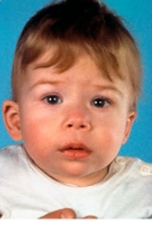Immunodeficiency–centromeric instability–facial anomalies syndrome
| ICF syndrome | |
|---|---|
| Other names: Immunodeficiency-centromeric instability-facial anomalies syndrome | |
 | |
ICF syndrome (or Immunodeficiency, Centromere instability and Facial anomalies syndrome)[1] is a very rare autosomal recessive[2] immune disorder.
Signs and symptoms

It is characterized by variable reductions in serum immunoglobulin levels which cause most ICF patients to succumb to infectious diseases before adulthood. ICF syndrome patients exhibit facial anomalies which include hypertelorism, low-set ears, epicanthal folds and macroglossia.[3]
Genetics
Mutations in four genes can cause this syndrome:[4] Cell division cycle associated protein 7 (CDCA7), DNA-methyltransferase 3b (DNMT3B), Lymphoid specific helicase (HELLS) and Zinc finger- and BTB domain containing protein 24 (ZBTB24).
The CDCA7 gene is located on chromosome 2 (2q31.1).
The DNMT3B gene is located on chromosome 20 (20q11.2)).[5][6]
The HELLS gene is located on chromosome 10 (10q23.33)
The ZBTB24 gene is located on chromosome 6 (6q21)
This disease is inherited in an autosomal recessive manner.[2]
Diagnosis
Diagnosis can occur using a karyotype or linkage analysis or DNA sequence analysis. This can occur prior to birth in families with a known history of the condition. [3]
Treatment
For ICF patients the most diffused therapy consists of repeated intravenous infusions of immunoglobulins for the patients entire lifespan. In 2007, Gennery et al. cured the humoral and cellular immunological defect in three ICF1 patients by hematopoietic stem cell transplantation (HSCT). The only side effect was related to the development of autoimmune phenomena in two of them.[7] This is the only documented case of restoring the immune conditions and growth improvement in these patients.[8]
See also
References
- ↑ Online Mendelian Inheritance in Man (OMIM): 242860
- ↑ 2.0 2.1 Brown, Dc; Grace, E; Sumner, At; Edmunds, At; Ellis, Pm (October 1995). "ICF syndrome (immunodeficiency, centromeric instability and facial anomalies): investigation of heterochromatin abnormalities and review of clinical outcome". Human Genetics. 96 (4): 411–6. doi:10.1007/BF00191798. PMID 7557962. S2CID 1459435.
- ↑ 3.0 3.1 Ehrlich, Melanie; Jackson, Kelly; Weemaes, Corry (1 March 2006). "Immunodeficiency, centromeric region instability, facial anomalies syndrome (ICF)". Orphanet Journal of Rare Diseases. 1 (1): 2. doi:10.1186/1750-1172-1-2. ISSN 1750-1172. PMC 1459120. PMID 16722602.
- ↑ Ren R, Hardikar S, Horton JR, Lu Y, Zeng Y, Singh AK, Lin K, Coletta LD, Shen J, Lin Kong CS, Hashimoto H, Zhang X, Chen T, Cheng X (2019) Structural basis of specific DNA binding by the transcription factor ZBTB24. Nucleic Acids Res
- ↑ Jiang, Yl; Rigolet, M; Bourc'His, D; Nigon, F; Bokesoy, I; Fryns, Jp; Hultén, M; Jonveaux, P; Maraschio, P; Mégarbané, A; Moncla, A; Viegas-Péquignot, E (January 2005). "DNMT3B mutations and DNA methylation defect define two types of ICF syndrome". Human Mutation. 25 (1): 56–63. doi:10.1002/humu.20113. PMID 15580563. S2CID 41614913.
- ↑ Online Mendelian Inheritance in Man (OMIM): 602900
- ↑ Gennery, A. R.; Slatter, M. A.; Bredius, R. G.; Hagleitner, M. M.; Weemaes, C.; Cant, A. J.; Lankester, A. C. (2007). "Hematopoietic Stem Cell Transplantation Corrects the Immunologic Abnormalities Associated with Immunodeficiency Centromeric Instability Facial Dysmorphism Syndrome". Pediatrics. 120 (5): e1341–e1344. doi:10.1542/peds.2007-0640. PMID 17908720. S2CID 11910398.
- ↑ https://www.ptglab.com/news/blog/icf-syndrome-a-gene-silencing-chromatin-disorder/ Archived 2022-05-22 at the Wayback Machine IFC Syndrome: A gene silencing chromatin disorder
External links
| Classification | |
|---|---|
| External resources |
- Orphanet Journal of Rare Diseases link to ICF syndrome [1] Archived 2015-09-07 at the Wayback Machine